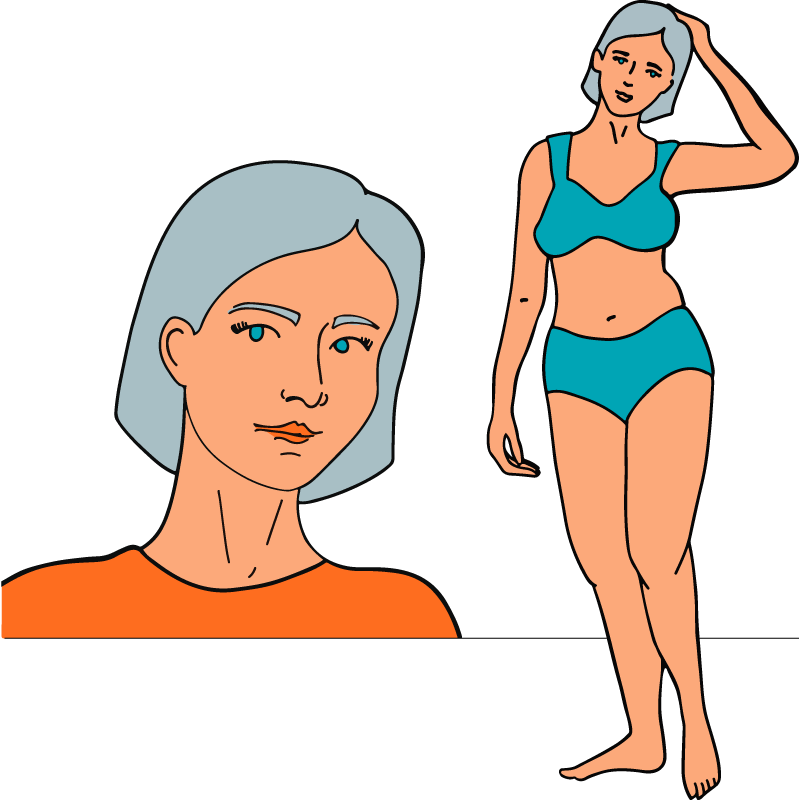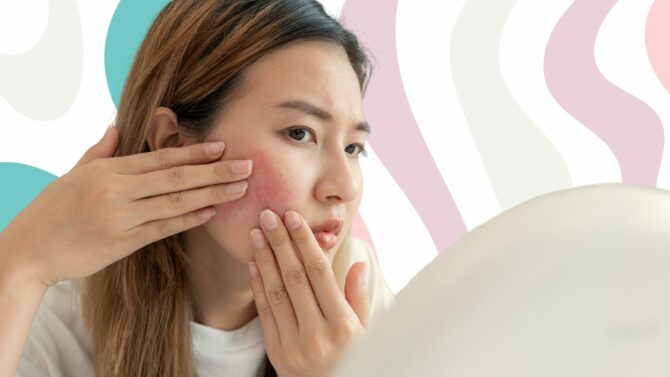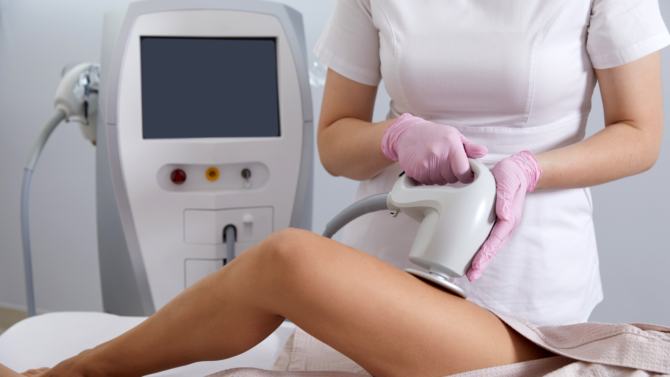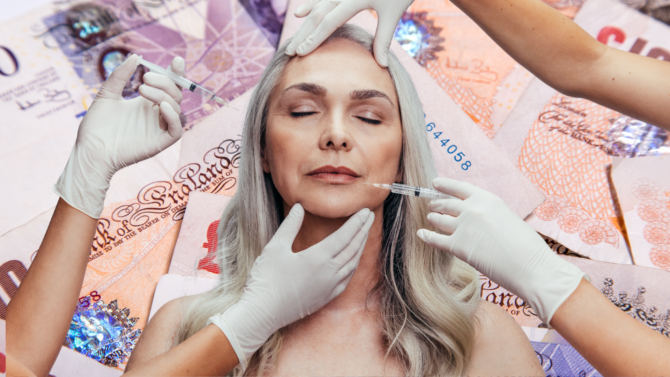What is sun damage?
Sun damage is the number-one catalyst that accelerates the skin’s normal ageing process and, when sun damage gets more severe, it results in symptoms of its own, which look a bit like part of the normal ageing process but actually aren’t. Confused? Stay with me and I’ll explain. If you boil it down, there are three levels of sun damage:
Stage one — limited damage that speeds up the natural ageing process, meaning your skin starts to look older, sooner;
Stage two — prolonged exposure which results in symptoms distinct from the normal ageing process;
Stage three — extensive damage which includes the above and also puts you at increased risk of skin cancer. I’m not going to talk about this one as it’s beyond the scope of this site—all I’ll say is: please look after your skin, wear sunscreen and make sure you never get to stage three.
Stage One – speeding up the ageing process
One of the features of sun damage is collagen degradation. UV exposure—even just a little bit—results in increased levels of an enzyme in the body called matrix metalloproteinase-1 (aka MMP-1), which is a primary factor in the breakdown of collagen. In general, the ageing process is marked by a number of symptoms which can all be traced back to the breakdown of collagen. So, by exposing your skin to the sun, it’s going to hurry up the onset of older-looking skin. That’s why skincare professionals spend so much time going on about the need to protect your skin from ultraviolet light.
The other thing you’ll come across with sun damage is a decrease in glycosaminoglycans (aka GAGs). Easier to say out loud than you’d think and a killer on the Scrabble board, this is the family of molecules that includes our old friend and skincare stalwart, hyaluronic acid. These molecules are famed for keeping your skin hydrated as well as cross-linking with collagen and elastin to make your skin firm and taut. Skin that has aged without sun exposure contains low levels of GAGs. UV exposure will get you to that same state, but much faster.
Finally, you can expect to see sun damage show up in the skin in the form of thread veins, aka telangiectasia, which are the clusters of veins near the surface of the skin that look like little road maps. As the collagen and GAG levels go down, the skin becomes thinner and loses its elasticity. Thin skin means you can see the subdermal veins more easily. Inelastic skin means that when those veins enlarge—perhaps through exercise, heat exposure, or drinking—the skin is less able to spring back and compress the veins back to their normal size. Thread veins tend to show up more as you get older, whether or not you are exposed to the sun, but UV exposure will speed up the process.
Stage Two – prolonged exposure resulting in distinct symptoms
With stage-one limited exposure, you can’t see the damage that’s being done as distinct from the normal ageing process. Once you enter stage two, however, you start to see the symptoms of prolonged UV exposure. I’ll list the symptoms here and break them down after:
Discoloured patches on your skin, darker than the surrounding tissue — aka solar lentigines (singular: solar lentigo), which are commonly called ‘age spots’;
Solar comedones — these are blocked pores, either open (blackheads) or closed (whiteheads), which are larger and more noticeable than your standard black/whitehead;
Localised thickening of the epidermis — aka actinic keratoses, which are little areas of scaly skin, roughly 1–2cm in diameter;
General thickening of the dermis — aka solar elastosis, which is where the skin becomes thicker, leathery and deeply wrinkled.
You’ll hear the term ‘age spot’ crop up regularly in the dermatological vernacular. However, it’s a little misleading, because the proper name is solar lentigo and, as the ‘solar’ part would imply, this phenomenon doesn’t occur without some UV exposure. That’s why you only see it on the face, hands and other parts of the body exposed to the sun. Since these spots take a while to appear, usually only showing up after age 60, they’re often falsely attributed to old age. (If you’re seeing spots of hyperpigmentation elsewhere on the body, or cropping up in your youth, it’s a different thing entirely. It could be lentigo simplex, but it could also be the result of a virus; so, if in doubt, go see a doctor.)
Solar comedones appear in later age (between 60–80 years old) and are far more common in men. Since they are due to UV exposure, you tend to see them in combination with the thick, yellow skin characteristic of solar elastosis; this combination is called Favre-Racouchot syndrome.
Actinic keratoses form after years of exposure to the sun. You could be fooled into thinking it’s just a strange patch of dry skin, akin to a small patch of sandpaper, or even a scab, but it’s actually a tell-tale sign of sun damage. If you find one, you know you’re not protecting yourself from the sun adequately, so start now in earnest to try and avoid further damage. If you find one that’s lumpy, tender, and/or bleeding, then go to a doctor immediately—a small number of actinic keratoses can turn into a form of skin cancer called ‘squamous cell carcinoma’ and any of these more severe symptoms could be early signs.
Solar elastosis is a hallmark of advanced photoageing. This is where prolonged exposure causes irregularities in the levels and arrangement of elastin fibres (that’s the substance that springs the skin back into shape when it’s tugged, i.e. elastic) in the dermis. The dermis is the layer of skin just underneath the epidermis; the epidermis being the outermost layer you can see and touch. What all this means is that the fibres become bunched up and tangled, resulting in thick and leathery skin. You’ll often find a yellow tinge as well, a bit like in long-term smokers, plus deep furrowed wrinkles. These are much deeper and more noticeable than the wrinkles you get from normal ageing.
I should point out that there are some very well-respected practitioners out there who are challenging the established orthodoxy that sun damage significantly speeds up the ageing process and, indeed, not all the studies out there are unanimous in their conclusions about the effect of UV exposure on skin ageing. I’m keeping careful tabs on this debate but, while there’s certainly some interesting research being done at the moment, I’m not about to stop wearing sunscreen every day.
Why do I have sun damage?
You don’t have to sit outside for hours on end without sunscreen to get the kind of sun damage that we talk about in the world of tweakments. Sitting by a window, going to the shops on a cloudy day, driving in your car; each of these activities will result in some degree of sun damage. In short, you have sun damage because you live on Earth—it’s all part and parcel of life. Unfortunately, these everyday levels of exposure will—without active management—inevitably result in premature ageing of the skin.
It’s not all doom and gloom, though, as your body—especially your skin—is very good at repairing itself. The problem with sun damage is that, unless you are nocturnal or live underground, it is inevitable and will accumulate faster than your body can deal with it—which is why you have to take precautionary measures and give your skin a fighting chance to keep up. Sunscreen, while it won’t block 100% of all damage, will shield you from the vast majority of UV radiation and bring it down to levels that your body can manage and even undo.
What does sun damage look like on the skin?
Apart from the obvious red burn and peeling skin that comes from massive overexposure, the long-term symptoms of UV light are commonly associated with ageing. The most common are:
- Telangiectasia — colloquially known as thread veins or spider veins;
- Solar lentigines — often just called age spots;
- Solar comedones — large, blocked pores;
- Actinic keratoses — small patches of dry, rough, uneven skin;
- Solar elastosis — systemic thickening of the dermis, leading to deep wrinkles and a leathery appearance.
For a more in-depth examination of these symptoms, scroll back up to the first section titled What is Sun Damage?
How can I prevent sun damage?
Well, the best way to prevent sun damage is to avoid the sun. I know, I know…that’s somewhat impractical if you’re not a Bram Stoker character, but it’s the only way to fully prevent sun damage. Of course, nobody expects you to abide by that every day, yet it’s worth bearing in mind that you generally want to avoid being in the sun if you don’t need to be in it.
One way of avoiding the sun that is slightly more practical than becoming a hermetic recluse is to cover up any exposed skin with clothing. Think long-sleeved tops and wide-brimmed hats. Dark colours work best.
What do you do otherwise? The answer is sunscreen. A lot of people think that sunscreen is just for holidays or the beach, particularly people who live in the UK where sunshine is something of a rare commodity. The truth is, you should always wear sunscreen. Even if you’re popping to the shops for five minutes on a cloudy day, any uncovered skin will still be receiving a dose of UVA and UVB rays, inevitably contributing to the photoageing process. Read over the next section for advice on what to look for in a sunscreen…
What sunscreen should I wear?
Sunscreen is designed to block out the sun’s harmful UV radiation, which comes in UVA and UVB format. The sun emits these rays in varying measure and strength throughout the day, so you always need to be on guard. But what makes a good sunscreen? Here are some things to bear in mind.
SPF is a useful measure, but it is also widely misunderstood. First of all, it only measures protection from UVB. That’s right, SPF may stand for ‘sun protection factor’, but it completely ignores a large part of the radiation that the sun emits. So you need more than just SPF. Always look for a sunscreen that either explicitly states that it guards against UVA or has the phrase ‘broad spectrum’ on it. UVA is the part of the spectrum of UV radiation that destroys your collagen levels, so this is particularly important for combating photoageing. Most sunscreens are made with a standard ratio of UVA to UVB protection, but it is worth checking.
As you’ll probably know, SPF comes in a range of values. It’s a common misconception that SPF30 is twice as effective as SPF15, but that’s not how the maths works. SPF15 will filter out about 93% of the sun’s UVB rays; SPF30 filters out around 97%; and SPF50 filters out roughly 98%—i.e. the increase in protection isn’t directly proportionate to the SPF value. So what do you go for? Keep to a minimum of SPF30. 93% might sound good, and it’s certainly better than nothing, but if you’re going to do it, do it right.
If you’re looking for a specific recommendation, head over to my list of favourite sunscreens.
How often should I apply sunscreen?
Every two hours and immediately after showering or swimming. UVA rays can pass through glass, so you’ll want to apply sunscreen when you’re inside, too.
Can I get rid of sun damage?
It depends what you’re talking about. In terms of the systemic effects of UV radiation on collagen and glycosaminoglycan levels in the skin, once you’ve got it—and, don’t worry, everyone gets it— you can’t “get rid” of it in the same way you might get rid of acne. However, you can definitely slow down the progress of systemic photoageing by using good skincare and appropriate tweakments. In fact, if you’re obsessive, you could probably even halt it in its tracks—for a spell. Unfortunately, though, there’s no way of actually turning back the clock.
Where you’ll have more joy, if you’re looking to undo the damage you’ve incurred, is in the symptoms that manifest with prolonged exposure, i.e. thread veins, solar lentigines (mottled patches of hyperpigmentation, or ‘age spots’, actinic keratoses (the dry, scaly patches), and solar elastosis (thick, leathery skin). While these are not insignificant issues, they can still be undone to a noticeable extent through the use of tweakments. Which ones? Read the next section to find out…
How do I treat sun damage?
Since UV rays get deep down into the nether layers of the skin, the most effective tools in your arsenal for combating sun damage are tweakments. Here’s a list of the common symptoms of sun damage and which tweakments can help:
- Collagen depletion — microneedling. One of my favourite ways of stimulating collagen production is microneedling. This is a procedure where a clinician goes over your skin with a spiky roller or needle-tipped machine, making thousands of tiny holes in the surface of the skin down to the dermal-epidermal junction. This stimulates a wound healing response in the form of collagen production. Look at the microneedling factsheet for more information. And, don’t worry, it’s nowhere near as bad as it sounds.
- Hyaluronic acid/glucosaminoglycan depletion — injectable moisturisers. There are many skincare solutions out there which contain hyaluronic acid and you might think these would be enough for sun damage. Unfortunately, the damage done by UV radiation is several layers down, so the chances of skincare touching the affected areas are slim. Instead, injectable moisturisers, which are made up of specially formulated hyaluronic acid, can be injected by the practitioner right down to where it needs to be, flooding the area with precious hyaluronic acid molecules. These attract and hold water, thereby improving hydration. Furthermore, as part of the wider range of glycosaminoglycans, hyaluronic acid plays a formative role in the production of collagen and elastin.
For any of the following, you are strongly advised to get an expert opinion on the state of your skin, in order to find the most appropriate and effective treatment.
- Thread veins — IPL, laser, microwave treatment and microneedling. The first two break up the red haemoglobin pigment in your veins, which means the body can get rid of it, thereby reducing the appearance of the thread veins. Microwave treatment involves passing a microwave current along sections of the thread vein, which causes it to shrivel up and disappear almost instantaneously. Microneedling doesn’t target thread veins directly, but by improving the collagen and elastin structures in your skin, the appearance of thread veins will be reduced.
- Solar lentigines — IPL and laser can break up the pigmentation (as it does with haemoglobin for thread veins) which allows it to be worked out through the lymphatic drainage system. Skin peels are also an option to even out any remaining irregularities. You can also go for microneedling, which stimulates collagen production and prompts skin resurfacing, which clears old, pigmented skin, though not in such a direct way as laser or peels.
- Solar comedones — you may want to start with a prescription retinoid to improve the skin, but you will need an appointment with a professional to extract them as these comedones are too deep-seated to be something that you can tackle at home.
- Actinic keratoses — assuming it’s not something your GP is worried about—see above why you need to be sure that these are not pre-cancerous before you book in for cosmetic treatment for them—you can look to laser skin resurfacing and chemical peels to address these. For more pronounced keratoses, you may need dermatological surgery or cryotherapy (freezing the patches off).
- Solar elastosis — this is damage to the deeper layers of the skin as well as the outside layer. Talk to an experienced practitioner about what approach would work best for you and follow their recommendations. You could start with prescription retinoic acid, to see what improvements that made. Or you could go straight to laser treatment, to repair the skin from the lower layers upwards, or a chemical peel, to soften the leathery top layer.
Can I use laser treatment for sun-damaged skin?
Absolutely, many of the common symptoms of sun damage can be effectively targeted by laser treatment. See the preceding section on treating sun damage for more information.
Does skincare help to undo sun damage?
Your skin is constantly trying to undo the damage wrought by UV radiation, so effective skincare will certainly be a welcome helping hand. Here are the types of products that will help you the most.
- Sunscreen. By far the most important thing you can do is apply a product with broad-spectrum UV protection, first thing in the morning then reapply it during the day. This will stop existing sun damage from getting worse and will guard against future damage.
- Vitamin C serum or other antioxidant serum. This will help your skin protect itself against environmental damage. That doesn’t mean you can use it instead of sunscreen, but think of this as having a supportive role. Well-formulated vitamin C products will also encourage collagen production in the skin, and reduce the formation of age spots, so they have a role in brightening the skin. Put on straight after cleansing, and before sunscreen.
- Hyaluronic acid. This well-known moisturising molecule – which works by holding many times its own weight in water – will help hydrate the outer layers of the skin, which in turn improves the function of the skin and helps strengthen the skin barrier. Apply hyaluronic acid serum or cream, after your vitamin C or antioxidant, and before your sunscreen.
- Retinol. Yes, retinol – which crops up for so many reasons in skincare, because it improves so many ways in which the skin functions, from boosting collagen production to reducing pigmentation and making old, sluggish skin cells behave like more energetic younger ones. Introduce it slowly into your regime, to allow your skin time to become accustomed to it
And in terms of prescription skincare:
- Retinoic acid: even better than retinol would be a prescription from a dermatologist for retinoic acid, which is many times more effective than retinol in regenerating skin renewal, reducing pigmentation and softening the look of sun-damage-induced wrinkles, and needs to be used cautiously as your skin adapts to it.
- Hydroquinone: this is the gold-standard pigment-busting ingredient, which is only available on prescription and can be combined with retinol to reduce pigmentation marks on the skin.












 The Tweakments Chatbot
The Tweakments Chatbot